Aureoboletus Pouzar
The only European member of this genus is usually easily recognized due to the combination of viscid cap cuticle, bright yellow unchanging hymenophore and the colours of the flesh.
Aureoboletus gentilis (Quél.) Pouzar
Description
Cap up to 7 cm, at first hemispherical then expanding to convex, pale pink to ochraceous, beige or very pale brown with more or less pronounced pinkish tint, distinctly viscid especially in wet weather. Stipe cylindrical, ventricose or clavate, usually tapering towards the base, mostly bright yellow and often paler towards the base, sometimes almost entirely cream-coloured, often in places with pinkish to brownish tinges. Flesh whitish or cream, always more or less pinkish under the cuticle, often spotted vinaceous in the stipe base, unchanging when exposed to air. Tubes bright yellow, unchanging when exposed to air. Pores bright yellow, unchanging when bruised. Smell not distinctive. Taste not distinctive. Spores 10.5–16 × 4.5–6 μm.
Habitat. Deciduous forests, mycorrhizal with oaks (Quercus) and beech (Fagus).
Distribution. Widespread in Europe, but rare in a number of countries.
Similarity. At first sight Aureoboletus gentilis probably might be confused with Xerocomus persicolor. The later however has dry cap cuticle, differently coloured blueing flesh and blueing pores.
Photographs
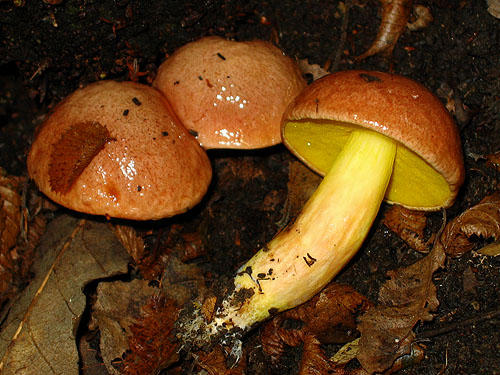
Fruitbodies of Aureoboletus gentilis. Note the bright yellow pores and the viscid cap cuticle. (photo B. Assyov)
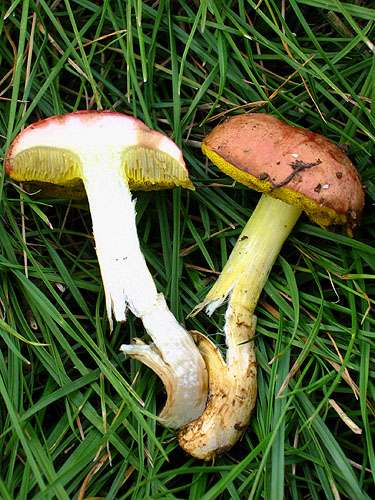
Aureoboletus gentilis has white unchanging flesh which usually stains pinkish under the cap cuticle. (photo B. Assyov)
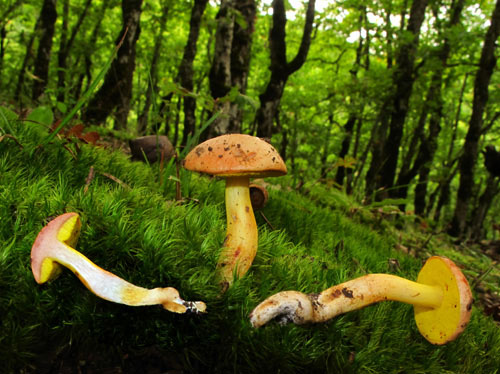
Fruitbodies of Aureoboletus gentilis. (photo G. Konstantinidis)
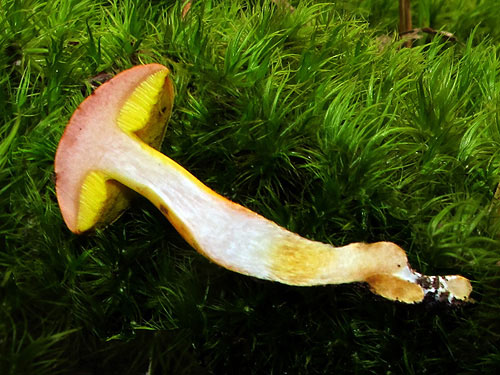
Sectioned fruitbody of Aureoboletus gentilis. Note again the golden yellow tubes and the pinkish colour pf the flesh in the cap. (photo G. Konstantinidis)
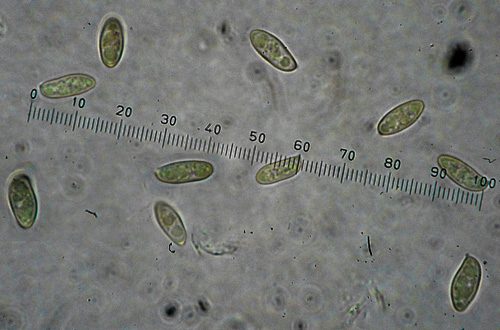
Basidiospores of Aureoboletus gentilis. (photo G. Konstantinidis)
Important literature
Alessio, C.L. 1985. Boletus Dill. ex L. (sensu lato). – In: Fungi Europaei. Vol. 2. Pp. 1–705. Libreria editrice Biella Giovanna, Saronno.
Estadès, A. & Lannoy, G. 2004. Les bolets européens. – Bulletin Mycologique et Botanique Dauphiné-Savoie 44(3): 3–79.
Galli, R. 1998. I Boleti. Atlante pratico-monographico per la determinazione dei boleti. Edinatura, Milano.
Knudsen, H. & Vesterholt, J. [eds.]. 2008. Funga Nordica. Nordsvamp, Kopenhagen.
Lannoy, G. & Estadès, A. 2001. Les Bolets. Flore mycologique d’Europe. Documents Mycologiques Mémoire Hors série no. 6. Pp. 1–163. Association d’Écologie et de Mycologie, Lille.
Muñoz, J.A. 2005. Boletus s. l. – In: Fungi Europaei. Vol. 1. Pp. 1–951. Edizioni Candusso, Alassio.
Pilát, A. & Dermek, A. 1974. Hríbovité huby. Československé hríbovité a sliziakovité huby (Boletaceae – Gomphidiaceae).Veda, Bratislava.
Šutara, J., Mikšík, M. & Janda, V. 2009. Hřibovité houby. Čeled’ Boletaceae a rody Gyrodon, Gyroporus, Boletinus a Suillus. Academia, Praha.
Watling, R. 1970. Boletaceae, Gomphidiaceae, Paxillaceae. – In: Henderson, D.M., Orton, P.D. & Watling, R. [eds]. British fungus flora. Agarics and Boleti. Vol. 1. Royal Botanic Garden, Edinburgh.
Watling, R. & Hills, A.E. 2005. Boletes and their allies (revised and enlarged edition). – In: Henderson, D.M., Orton, P.D. & Watling, R. [eds]. British Fungus Flora. Agarics and boleti. Vol. 1. Royal Botanic Garden, Edinburgh.